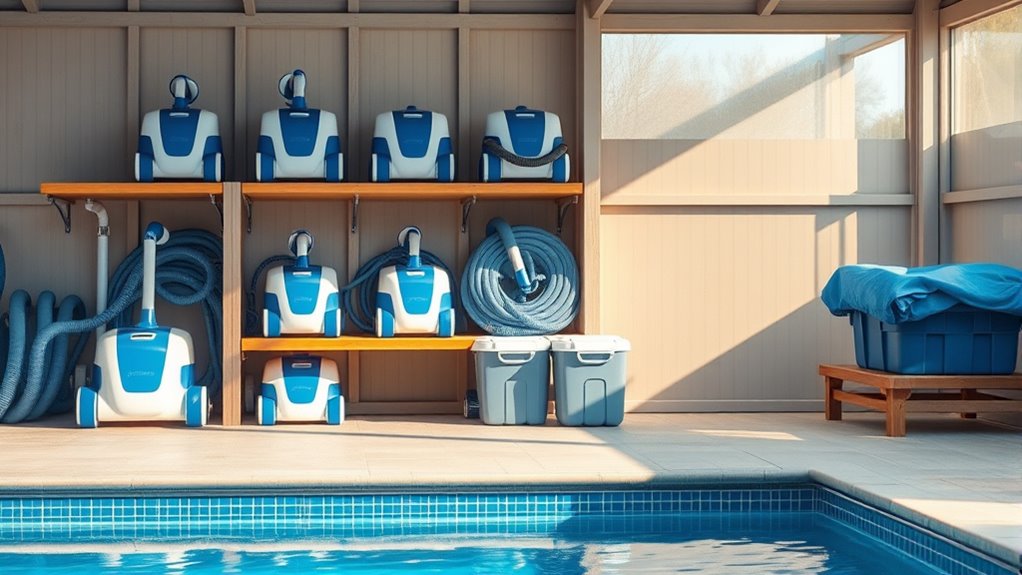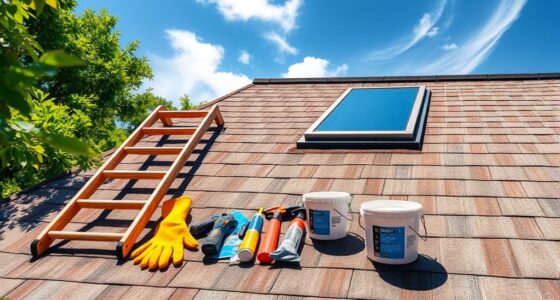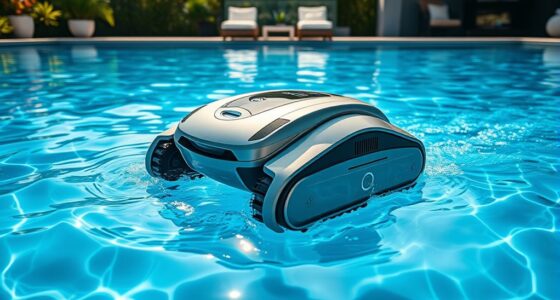To store your automatic pool cleaner for the off-season, first clean all parts and rinse away debris. Drain all water, dry thoroughly, and inspect for damage or worn components, replacing as needed. Store it in a cool, dry, and well-ventilated area, ideally protected from pests and moisture with covers or containers. Regular checks keep everything in good shape, ensuring you’re ready for next season—continues to hold useful tips for proper storage.
Key Takeaways
- Thoroughly clean, inspect, and repair all parts before storage to prevent damage during the off-season.
- Fully dry all components and compartments, applying protective lubricants if necessary.
- Store in a cool, dry, and well-ventilated area away from direct sunlight and humidity.
- Use airtight containers or covers with desiccants to prevent moisture and pest infiltration.
- Perform a maintenance check and run the cleaner briefly in fresh water before long-term storage.
Cleaning and Preparing Your Pool Cleaner Before Storage
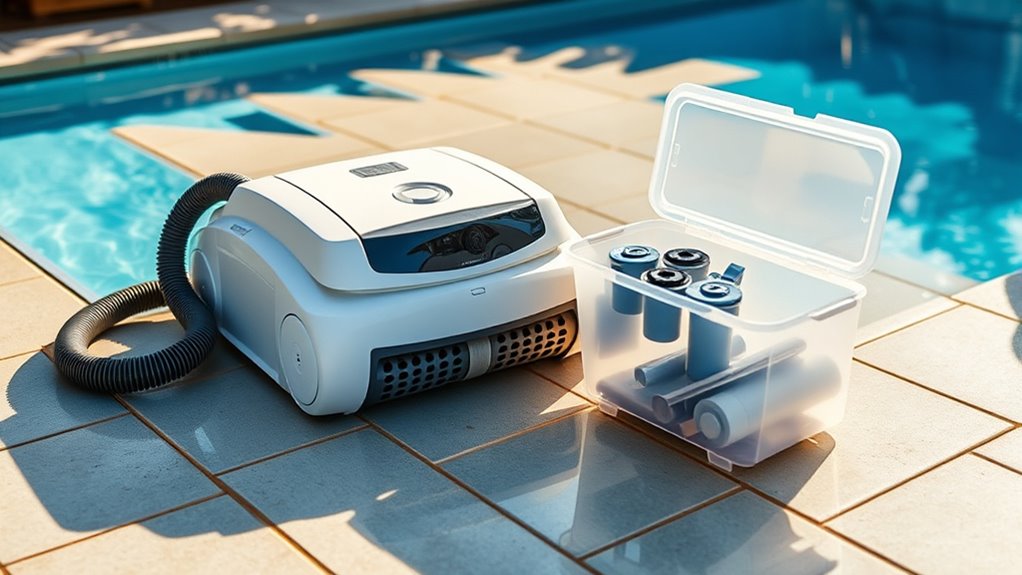
Before storing your pool cleaner for the off-season, it’s vital to thoroughly clean and prepare it. Start by removing debris and rinsing the entire unit with clean water to prevent buildup. Proper battery maintenance is essential—fully charge the battery, then disconnect or remove it to avoid deterioration during storage. This helps preserve its lifespan and guarantees it’s ready for use next season. Cable management is equally important; neatly coil the power cord without sharp bends or twists to prevent damage. Inspect the cable for wear or fraying, and repair if needed. Keeping the cleaner clean and properly stored will extend its life and make setup easier when you’re ready to use it again. Additionally, consulting the manufacturer’s guidelines can ensure you follow the recommended storage procedures for your specific model. Implementing storage best practices can further protect your equipment and maintain its performance over the off-season. For added protection, consider storing the cleaner in a climate-controlled environment to prevent damage from temperature fluctuations. Proper battery care can help ensure your cleaner remains in optimal condition year after year.
Draining and Removing Water From the Device
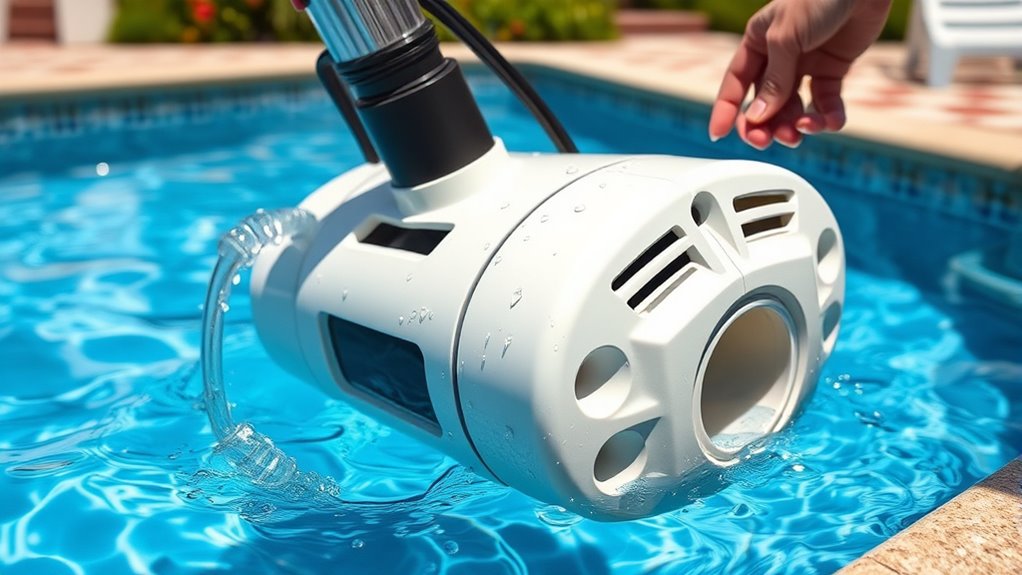
To prevent mold, corrosion, and damage during off-season storage, it’s vital to drain all water from your pool cleaner thoroughly. Start by disconnecting the device from the power source and removing any hoses or fittings. Use a gentle stream of water to assist with water removal from all compartments, including the brushes and chambers. Tilt or hold the cleaner at different angles to guarantee no water remains inside. Pay special attention to areas prone to trapping water, such as the intake and filter chambers. Proper device drainage helps prevent mold growth and corrosion, extending your cleaner’s lifespan. Be mindful of filtration systems, which are crucial for capturing debris and allergens, and ensure they are completely dry before storage. Additionally, using proper storage techniques can further preserve your equipment and prevent issues when you resume use. For added protection, consider applying a light coating of protective lubricant to moving parts before storage. Once you’re confident all water has been removed, dry off the device completely before storing it. This step assures your pool cleaner stays in excellent condition throughout the off-season. Ensuring you also check the moisture levels in all compartments can help prevent residual dampness that might cause problems later. Incorporating AI in maintenance principles, such as monitoring moisture levels, can optimize storage conditions and prolong device life.
Inspecting for Damage and Performing Necessary Repairs
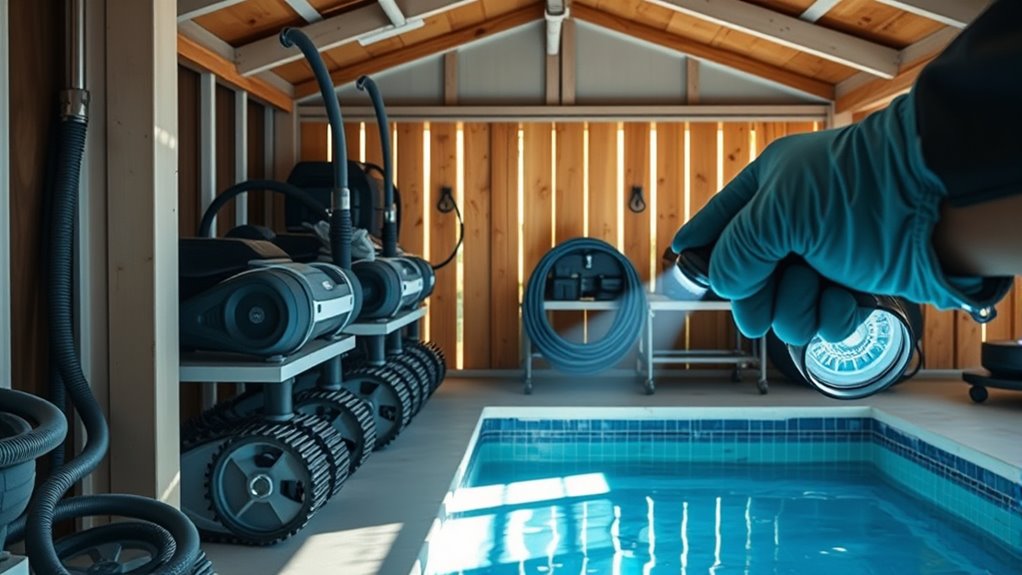
Before storing your pool cleaner, check it carefully for cracks or leaks that could worsen over time. Test all moving parts to make certain they still operate smoothly, and replace any worn components. Addressing these issues now helps keep your device in top shape for next season. Ensuring proper maintenance practices can prevent more costly repairs later. Additionally, inspecting for nutrient-rich ingredients can help prevent buildup or damage from debris that may have accumulated during the cleaning season. Incorporating regular cleaning routines can also contribute to the longevity of your pool cleaner. Staying informed about industry trends can also guide you in selecting the best repair and storage techniques to prolong your cleaner’s lifespan. Regularly checking tuning techniques can further optimize your pool cleaner’s performance and durability.
Check for Cracks or Leaks
Inspecting your pool cleaner for cracks or leaks is a crucial step in off-season storage. Start by carefully examining all hoses, seals, and joints for signs of crack detection issues. Look for any visible cracks, tears, or deformities that could cause leaks. If you find a crack or notice moisture around seals, perform leak repair immediately to prevent further damage during storage. Tighten or replace damaged hoses and seals as needed. Ensuring there are no leaks helps maintain the cleaner’s condition and prevents mold or mildew buildup. Addressing cracks or leaks now prevents further deterioration and ensures your cleaner stays in good shape through the off-season and is ready for use when the pool season resumes. Proper inspection and repair save you time and money later. Additionally, implementing preventive maintenance strategies can extend the lifespan of your pool cleaner and improve its performance in the next season. Incorporating AI-enhanced diagnostics can help identify hidden issues more effectively, safeguarding your equipment. Regular inspections and timely repairs contribute to long-term durability and optimal functioning of your pool cleaner. Being proactive with damage prevention techniques can further reduce the risk of costly repairs in the future.
Test Moving Parts
Since moving parts are essential for your pool cleaner’s performance, it’s important to carefully examine them for damage or wear. Check all moving parts, such as brushes, wheels, and propellers, for cracks, bending, or corrosion. If you notice stiffness or unusual noise during manual movement, it indicates they may need lubrication. Use appropriate lubrication tips to ensure smooth operation—apply a silicone-based lubricant sparingly to pivot points and joints. Avoid over-lubricating, which can attract debris. Test each component by gently moving them to ensure they rotate freely without resistance. Damaged or stuck parts can hinder cleaning efficiency, so address any issues promptly. Regular inspection and proper lubrication will keep your automatic pool cleaner functioning reliably during storage and beyond. Proper routine maintenance is crucial to prevent future issues that could compromise your equipment’s longevity, especially considering the importance of routine maintenance in extending the lifespan of your device. Incorporating inspection techniques can help identify potential problems early. Additionally, understanding AI in Business can offer insights into automating and optimizing your maintenance routines for better efficiency.
Replace Worn Components
Regularly examining your pool cleaner for worn or damaged components is essential to maintaining peak performance. If you notice cracks, tears, or signs of wear, replace worn components promptly to prevent further damage. Replacing worn components guarantees your cleaner operates efficiently and extends its lifespan. Consider upgrading parts, such as brushes or tracks, to newer, more durable options that improve cleaning power. When inspecting, check seals, hoses, and the drive motor for any signs of deterioration. Performing necessary repairs and upgrading parts before storage helps prevent issues during the off-season. Keep your cleaner in prime condition by addressing worn components early, ensuring it’s ready for effective use when you reopen your pool. Proper maintenance now saves time and money later. Incorporating body awareness into your routine can help identify early signs of wear, preventing minor issues from escalating into major repairs. Additionally, understanding retail hours for related supplies can help you plan timely replacements and repairs before your pool season ends.
Proper Cleaning and Drying Procedures
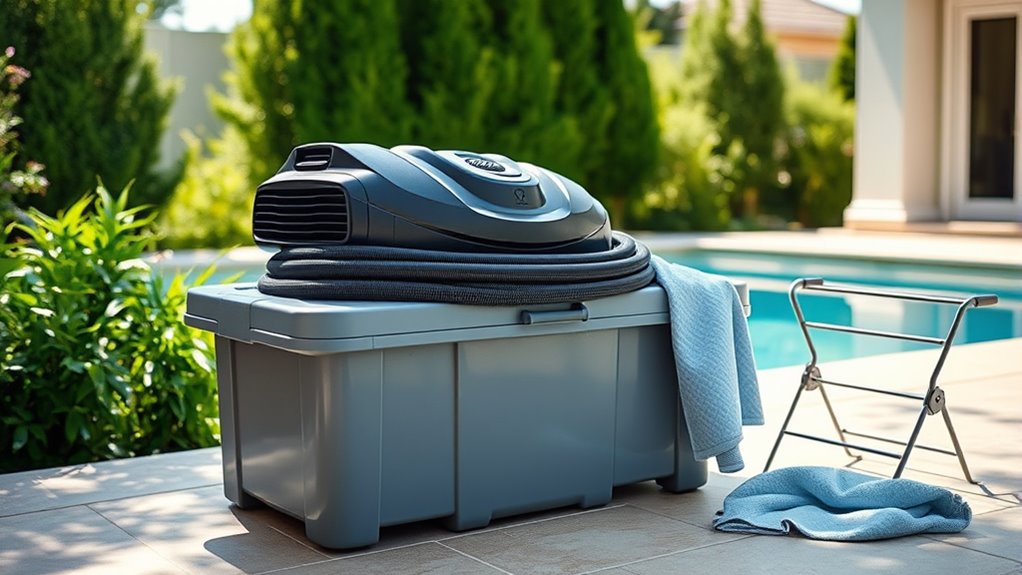
To guarantee your pool cleaner stays in top condition during off-season storage, it’s essential to thoroughly clean and dry all parts. Use effective cleaning techniques to remove dirt, debris, and any residual pool chemicals. Rinse the cleaner with fresh water, paying close attention to brushes, filters, and wheels. Next, employ proper drying methods to prevent mold and corrosion. Wipe down components with a clean cloth and allow them to air dry in a well-ventilated area. Ensure all parts are completely dry before storage, especially moving parts and electrical connections. Avoid leaving moisture trapped inside. Proper cleaning techniques combined with thorough drying will help maintain your cleaner’s performance and extend its lifespan during the off-season.
Storing in a Suitable Location
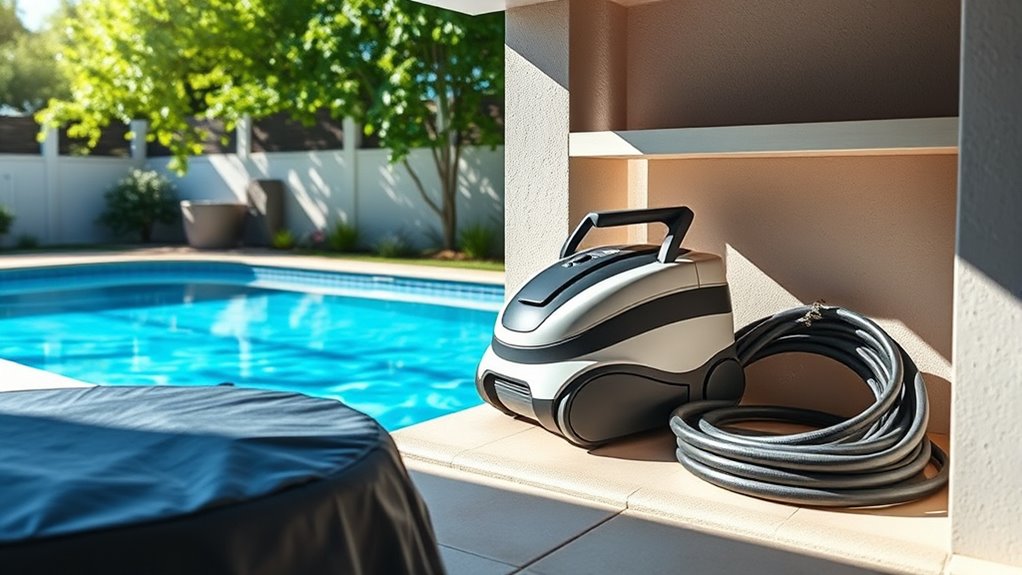
You should select a dry spot to store your pool cleaner, away from moisture that could cause rust or mold. Keep it out of direct sunlight, as UV rays can damage plastics and degrade parts over time. Choosing the right location helps guarantee your cleaner remains in good condition for next season.
Choose a Dry Spot
Choosing a dry, well-ventilated spot is essential for properly storing your pool cleaner during the off-season. When selecting a location, focus on choosing a dry spot that stays free from moisture, as damp areas can lead to mold and damage. Avoid storing your cleaner in basements or storage rooms prone to humidity, which can cause parts to deteriorate or develop mold. Instead, find a spot that maintains a consistent, dry environment, such as a closet or a dedicated storage cabinet. Ensuring proper ventilation helps prevent musty odors and keeps your cleaner in good condition for next season. Remember, the key is avoiding damp areas that could compromise the cleaner’s components or lead to corrosion over time.
Keep Away From Sun
Storing your pool cleaner out of direct sunlight is essential because prolonged exposure to UV rays can cause plastic parts to crack, fade, or weaken over time. To guarantee maximum UV resistance, choose a shaded storage area that provides consistent shade protection. This helps preserve the integrity of your cleaner’s components and extends its lifespan. Consider these tips:
- Store in a shed or garage with minimal sunlight exposure
- Use a cover or tarp to shield your cleaner from UV rays
- Avoid placing it near windows or glass doors that magnify sunlight
- Keep it in a cool, dry place to prevent heat buildup and further damage
Prioritizing shade protection not only safeguards your cleaner’s plastic parts but also maintains its overall functionality during the off-season.
Protecting Against Pests and Moisture
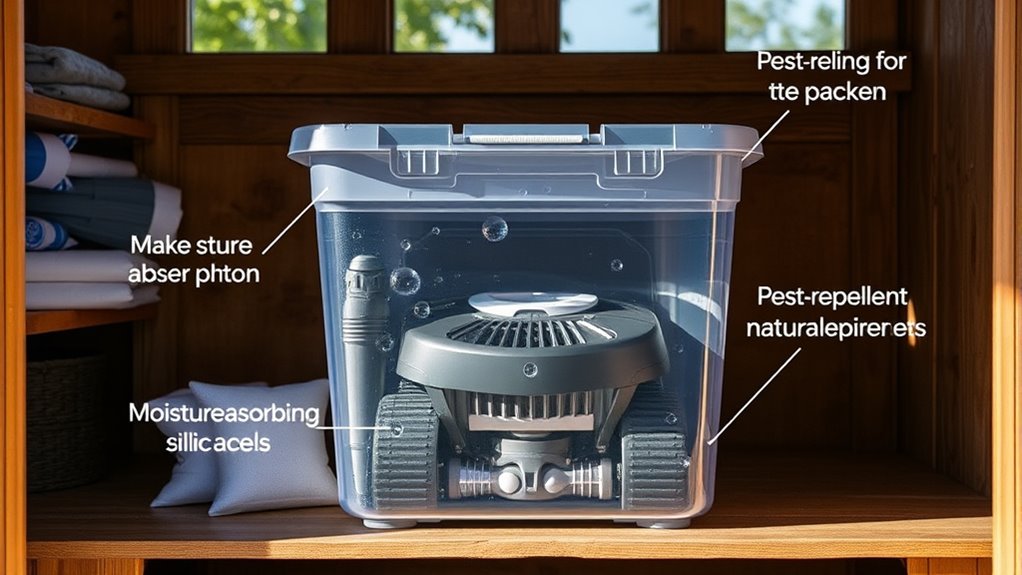
To effectively protect pool cleaners during off-season storage, safeguarding against pests and moisture is vital. Pest prevention keeps rodents and insects from nesting in your equipment, while moisture control prevents mold and corrosion. Store your cleaner in a dry, well-ventilated area, and consider adding desiccants or silica gel packs to absorb excess humidity. Use the following table to identify key steps:
| Action | Purpose | Tips |
|---|---|---|
| Seal storage area | Pest prevention | Use tight-fitting lids or doors |
| Use moisture absorbers | Moisture control | Place silica gel packs nearby |
| Regular inspection | Detect pests or moisture | Check periodically for signs |
Following these steps ensures your cleaner stays pest-free and dry during the off-season.
Using Storage Containers or Covers for Extra Protection
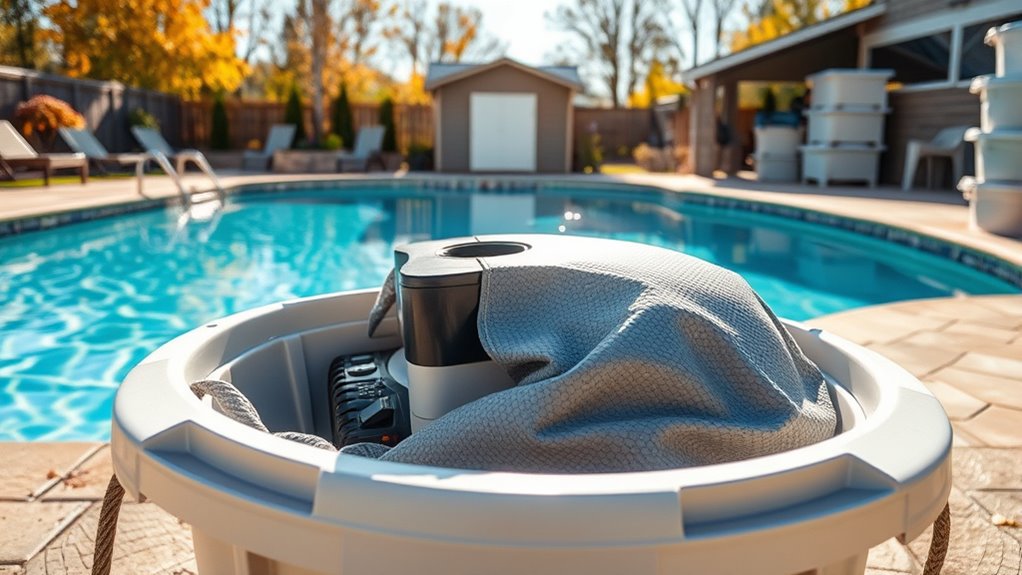
Using storage containers or covers provides an extra layer of protection for your pool cleaner during off-season storage. A sturdy storage container shields your cleaner from dust, debris, and accidental damage. Pool covers can be used to safeguard the equipment from dirt and pests, especially if stored outdoors. When selecting storage options, consider these points:
- Use airtight storage containers to prevent moisture buildup
- Choose durable, UV-resistant pool covers for outdoor storage
- Elevate containers off the ground to avoid contact with standing water
- Secure covers tightly to prevent wind from displacing them
These measures help keep your pool cleaner in top condition, ready to use when swimming season resumes. Proper storage using containers or covers extends the lifespan of your equipment and minimizes maintenance needs.
Regularly Checking on Stored Equipment During Off-Season
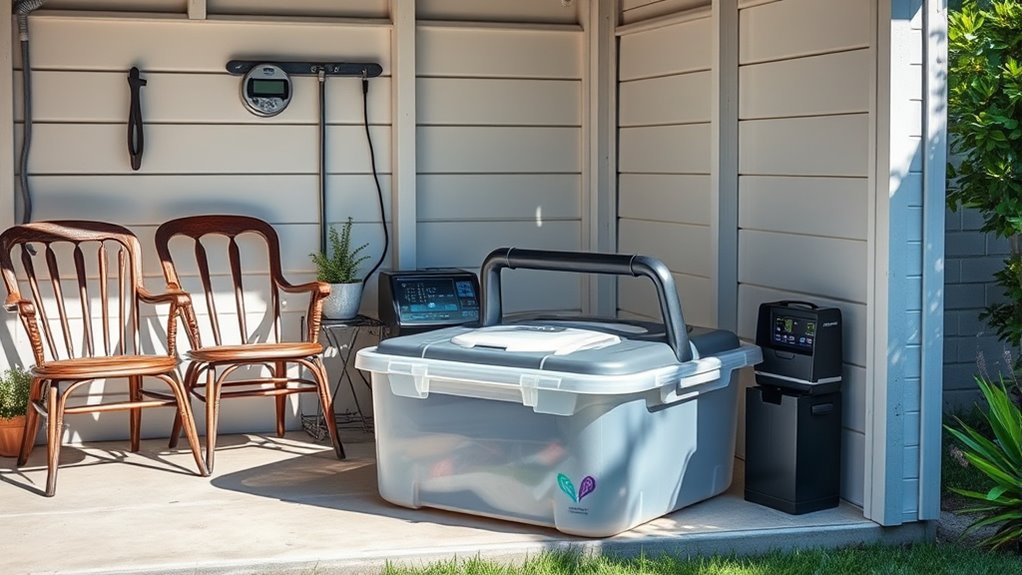
Since equipment can deteriorate even when not in use, it’s important to check on your pool cleaner regularly during the off-season. Establish a simple maintenance schedule, such as inspecting every few weeks, to catch any issues early. During these checks, look for signs of damage, corrosion, or wear, especially around storage accessories like brushes, hoses, and seals. Keep your equipment clean and dry, and ensure all parts are accounted for and in good condition. Regular inspections help prevent surprises when you’re ready to use your cleaner again. Using the right storage accessories, like secure covers or containers, makes it easier to monitor and maintain your equipment properly. Staying attentive ensures your pool cleaner remains in top shape for the next swimming season.
Getting Your Pool Cleaner Ready for the Next Season
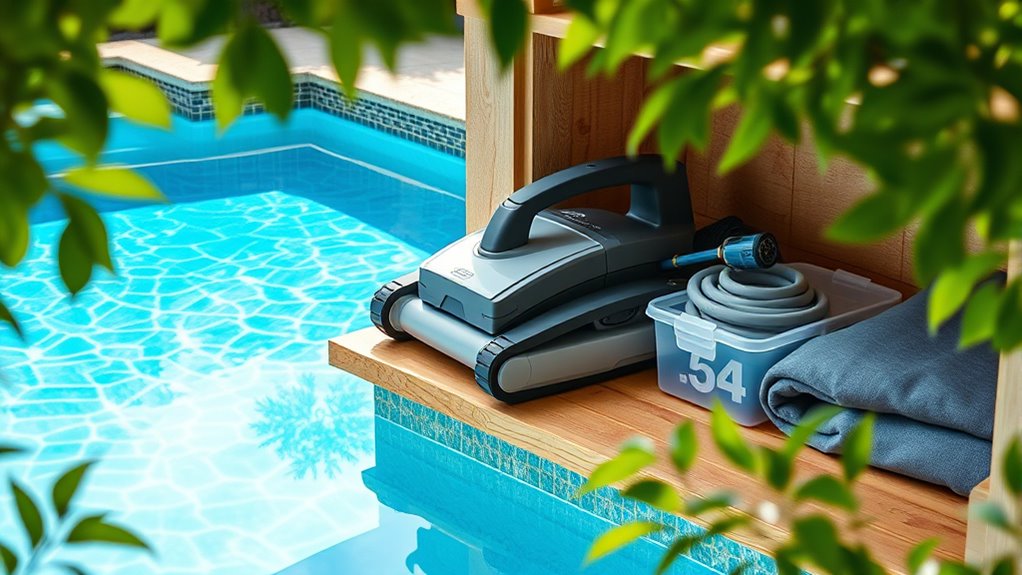
As the off-season comes to an end, it’s important to prepare your pool cleaner so it’s ready for the upcoming swimming season. Start by inspecting and cleaning all parts, including brushes and filters. Check the water circulation system to ensure it operates smoothly, as poor circulation can affect your cleaner’s performance. Before storage, rinse the cleaner thoroughly to remove any residual pool chemicals that could cause corrosion. Lubricate moving parts if necessary, and store it in a dry, cool place. Consider running the cleaner briefly in fresh water to keep internal components free of buildup. Proper preparation helps prevent damage and guarantees your cleaner performs efficiently when it’s time to hit the pool again. Keep these steps in mind for a seamless transition into the new season.
Frequently Asked Questions
How Long Can a Pool Cleaner Be Stored Without Maintenance?
You can store your pool cleaner for several months without maintenance if you prepare it properly. Typically, a storage duration of up to 3-4 months is fine without additional maintenance, but you should still check it periodically. To avoid issues, guarantee you clean the filter and brush before storage, and perform a maintenance check every month or so. Proper off-season storage helps keep your cleaner in good condition longer.
Can You Store an Automatic Pool Cleaner Outdoors During Winter?
Storing your automatic pool cleaner outdoors during winter is like leaving a delicate flower exposed to harsh weather. It’s not recommended, as outdoor storage exposes it to snow, ice, and moisture, risking damage. To guarantee winter protection, store it in a dry, sheltered area instead. If outdoor storage is unavoidable, use a waterproof cover and ensure it’s thoroughly cleaned and dried first, giving it a fighting chance against winter’s chill.
What Signs Indicate My Cleaner Needs Repairs Before Storage?
You should check your automatic pool cleaner for signs like excessive bristle wear or unusual motor noise before storing it. If the bristles are frayed or worn down, it could impact cleaning efficiency later. Similarly, if the motor makes strange noises or struggles to operate smoothly, it might need repairs. Address these issues now to guarantee your cleaner is in good shape and ready for the next season.
Is It Necessary to Remove Batteries Before Storing the Device?
Think of your cleaner like a loyal sidekick—taking care of its batteries guarantees it’s ready for action. You should remove the batteries before storing, preventing corrosion or damage. Also, perform charger maintenance by unplugging and cleaning contacts. This keeps your device in top shape, just like tuning a trusty vehicle before a long rest. Proper battery removal and charger care extend your cleaner’s lifespan, ready for next season’s splash.
How Often Should I Check on My Stored Pool Cleaner During Off-Season?
You should check on your stored pool cleaner at least once a month. Follow your storage tips by inspecting for any signs of damage or wear, and make certain the device remains clean and dry. Keep to a maintenance schedule that includes charging batteries, if applicable, and storing it in a cool, dry place. Regular checks help prevent issues and ensure your cleaner’s ready to go when the season starts again.
Conclusion
Proper off-season storage keeps your pool cleaner in top shape, saving you time and money next season. Did you know that neglecting storage can reduce your cleaner’s lifespan by up to 30%? By following these simple steps—cleaning, drying, and protecting your device—you guarantee it’s ready to go when you need it. Keep an eye on it during the off-season, and you’ll enjoy a hassle-free start to your pool season every time.
